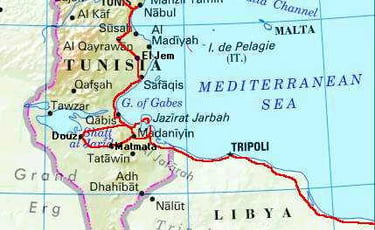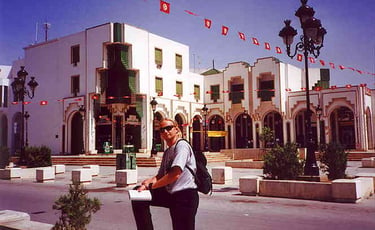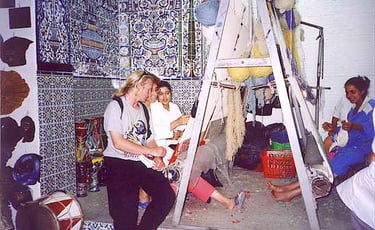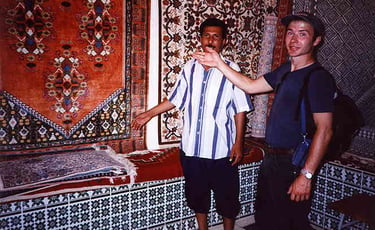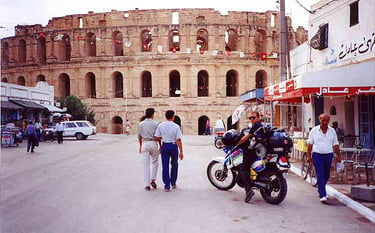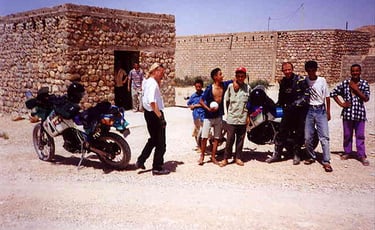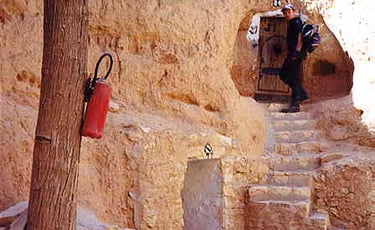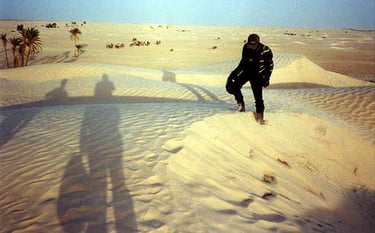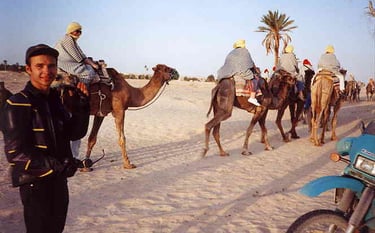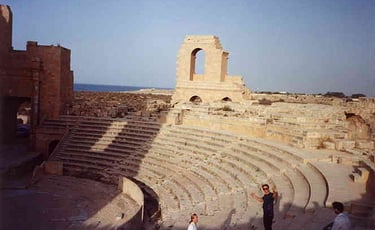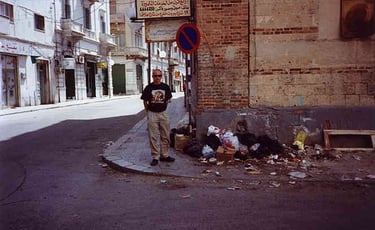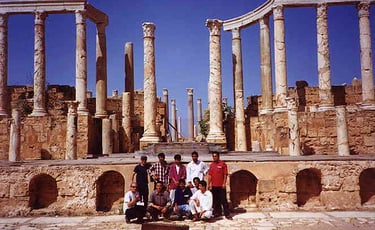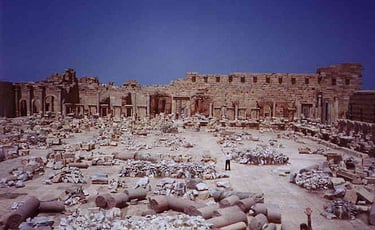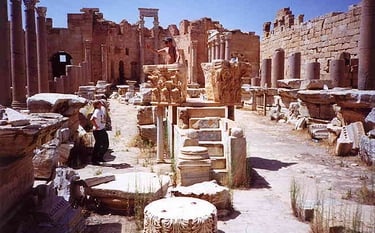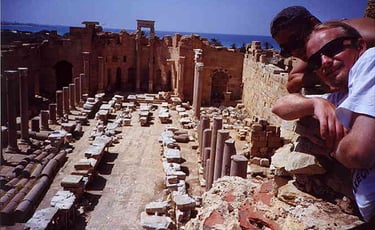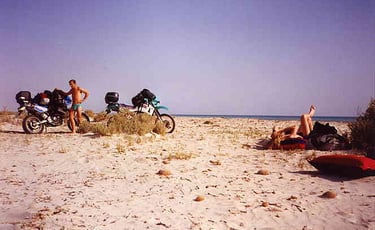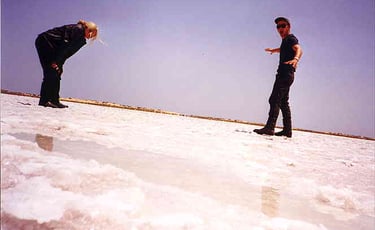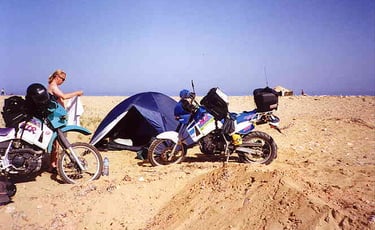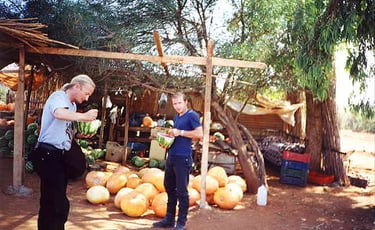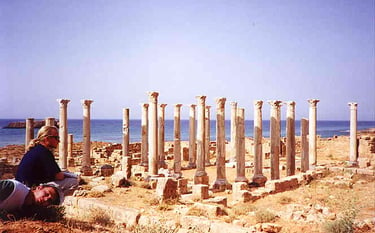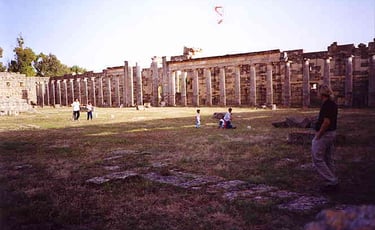GREG AND JACEK TRAVEL TOGETHER
1998
AROUND
MEDITERRANEAN
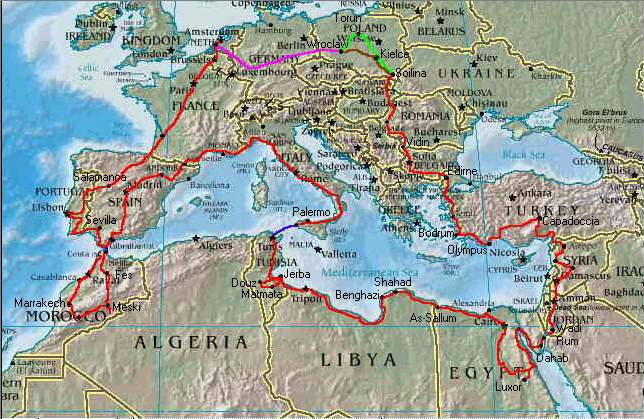

PREPARATIONS
J: Greg has been moped- and motorbiking since he was a teenager. In 1993 he and Lucas flew to Poland, bought an old Czechoslovakian made Jawa and drove to Spain and back. In 1996 they opted for a decent bike, ‘92 Kawasaki KLR 650. From Amsterdam they went to Spain, then to Italy, Greece, Istanbul in Turkey and back to Poland. The next trip in 1998 was supposed to suppress both previous adventures. Also this time each traveler was to ride his own bike.
IDEA
G.: Since the conclusion of our (Greg and Lucas’) Euro-tour ’96, Lucas and I started throwing ideas about another expedition. We had several plans but the most exciting proposition seemed to be encircling the Mediterranean Sea. Visiting the Arab countries, going to the desert and seeing the Pyramids were the main reasons. I have to admit that the idea was mine but I did not really believe anybody would go for that. I was pleasantly surprised when one day Lucas told me: “We are going to go.” Awesome, I thought, but I did not treat his decision seriously, at least not yet. Since then Lucas became the driving force and without his determination the trip wouldn’t have happened. When Lucas bought his bike in the fall of ’97 I knew we would go.
The original plan was to visit all the North African countries and do it on two bikes. So far Jacek was just an observer and despite me asking, he seemed not to be convinced to join us. Finally in January ’98 Jacek made a big decision and purchased a nearly new KLR. He would join us, however, under one condition: we wouldn’t go to Algeria. I suppose we could compromise and skip a civil war torn country, plus, it would be more fun with three people.
G.: I started the preparations in September ’97. I contacted the diplomatic institutions of all the concerned countries. Since we held Canadian passports it seemed like we only needed to obtain visas for Algeria, Libya, Egypt, Syria and Jordan. Apparently obtaining visas for Egypt, Syria and Jordan was supposed to be very easy. I was advised to wait till March ’98. Getting visas for Algeria was not impossible since we did not want to go to the north of the country but it would take some more phone calls. The biggest headache was to get visas to Libya. Libya is a people’s country, if you know what I mean, and tourists are a rarity there. One may not just receive a visa for travel purposes, one must have an invitation – that’s what the Libyan Mission representative in New York told me. Since it was nearly impossible to find someone inside Libya to invite us, I had to look for other options. I contacted the Libyan embassy in Warsaw, Poland (we also hold Polish passports). I was told it wouldn’t be a problem but I had to contact them in January. Great, I thought. Now we just waited. When I phoned them in January I was told a totally different story. Now it was impossible to receive visas in Poland. I did not get discouraged and I started phoning some of the independent travel agencies in Libya. I found their phone numbers on the Internet. It was hard. Not all of them spoke English and some did not even respond. On one January day I was reading a new Lonely Planet book “Africa on a Shoestring”. There I found some more phone numbers of new travel agents in Libya. One agent spoke very good English and was more than happy to help. We exchanged several faxes. I sent him all the documents he requested and we were all set. We would get our Libyan visas in Tunis. I still was a bit apprehensive but at least now we had a chance. Now, I have to thank these very nice agents for making it possible for us to visit their country. You are great. Thanks!!!
In the spring we sent our passports to each embassy and within weeks we had all visas. We also started collecting all necessary gear: tires, chains, chain lubes, tubes, luggage mounting and what not. Nearly half of our luggage was spare parts. We also had to do thorough tune-ups just to make sure everything worked. In the meantime, Lucas and Jacek were exercising heavily their riding skills.
The next step was to build appropriate crates. Since I already had one from the previous trip, we built two more for Jacek and Lucas. Two weeks before our flight to Amsterdam, we took the bikes apart (forks, wheels, handle bars, blinkers, etc.) and stuffed everything into the crates. We rented a truck and drove to Toronto to drop off the packages at the shipping warehouse. To ship the bikes to Holland, we used a reliable Canadian-Dutch company “Damco Maritime”. We would pick up our bikes in Rotterdam, Holland. We would also buy the European liability insurance in Holland.
As a part of preparations we also read a lot. We all agree that the Lonely Planet guidebooks are your best friend when on the road. Don’t hesitate to buy one when planning a trip.
STATISTICS
May 18 - August 28 1998
Countries visited: 20
Continents visited: 3
Kilometers: 25,009 (Rotterdam to Rotterdam)
Motorbikes used: Greg's blue 1992 Kawasaki KLR 650 (at the end of the trip: 1959 Junak) and Jacek's teal 1995 Kawasaki KLR 650.
Equipment failures/problems 1992 Kawasaki (Greg's)
broken gear shifter - replaced with extra one in Palermo, Italy; fixed in a garage in Turkey
broken fastening of the bin - fixed in Palmyra, Syria
numerous problems with CBRadio connections
numerous screws lost
Equipment failures/problems 1995 Kawasaki (Jacek's)
broken chain (pin lost) - reconnected near Bayonne, France
battery failure - bought a new one in Suez, Egypt
broken rear view mirror - fixed with wire in Luxor, Egypt
broken gear shifter - fixed in a garage in Turkey
numerous problems with CBRadio connections
numerous screws lost
Around US $700 each spent on gas (each bike)
The cheapest gas: Libya - 5 cents a litre
Pictures taken: around 750
EUROPE
Mon, May 18, 98. CANADA: Flight to Amsterdam
J.: We left Hamilton and Oakville full of excitement and ready for a big adventure.
The flight was uneventful. We spent the first night Mon/Tue 18/19 on the plane.
Tue, May 19, 98. HOLLAND: Amsterdam
J.: In Amsterdam, we bought motorcycle insurance (so called “green card”). Our shipment was late so we spent the day walking around the city and enjoying warm spring weather. By chance we came across a slogan written on a tram:
IT’S BETTER TO TRAVEL ONE MILE
THAN TO READ A THOUSAND BOOKS.
This became our motto.
G: This was the year of the France ’98 football world cup. I felt this spirit right after leaving the Amsterdam train station. There was a huge screen with a football game (what else…) right in front of the station. We were about to experience two things, travel and being close to the cup games.
Wed, May 20, 98. HOLLAND: Amsterdam (Harlem)
J.: We spent the night Tue/Wed 19/20 in a youth hostel in Harlem near Amsterdam. Later on Wednesday we took a train to Rotterdam.
Thu, May 21, 98. HOLLAND: Rotterdam
J.: Thursday was a national holiday and we had to wait till Friday to get our bikes. We spent the night Wed/Thu 20/21, Thursday and night Thu/Fri 21/22 sitting in a hotel and sleeping. Rotterdam was very boring
G: At least I had a chance to see this city and its hot spots. Rotterdam was completely destroyed during WW 2.
Fri, May 22, 98. HOLLAND: Rotterdam.
J.: Finally we were able to get our bikes. We spent about 5 hours putting our machines together and repackaging our luggage. Every smallest part of our equipment had to have its place.
We set off in the afternoon, drove approx. 100 km and spent the night Fri/Sat 22/23 somewhere in Holland on a small private campsite. Well, that was a cold night. Our first night out camping was the coldest night we would have experienced during the whole trip.


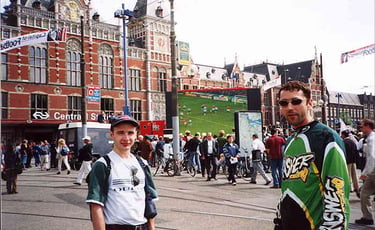

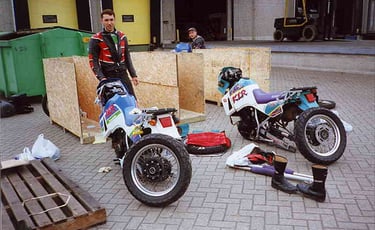


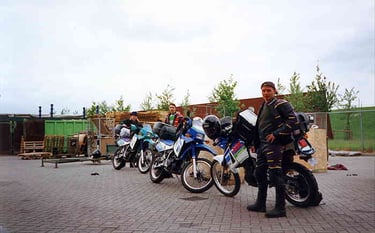

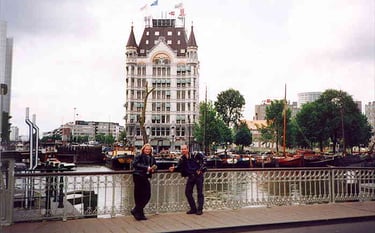
Sat, May 23, 98. HOLLAND/FRANCE
J.: We headed for Paris. We were avoiding toll routes, as they were awfully expensive, and chose main roads. No one seemed to follow the speed limits, especially motorcycle riders. Lukas lost few screws from the radiator cover, but that was an easy-to-fix problem. The bikes were great, the riders too. The 3-way CB Radio communication was faulty. There were constant distortions. It needed some major adjustments. We decided to fix it later.
We arrived in Paris late that evening (around 9 p.m.). It was difficult to find a campsite. It was already dark, roundabouts were confusing, we couldn’t count on CB radio and we couldn’t afford to lose each other in the traffic. We asked a Frenchman for directions (Greg speaks French and lots of other languages too). This “nice” guy simply refused to help us saying that it was the police we should have asked for directions. His help wasn’t essential—we found the camp anyway and spent the night Sat/Sun 23/24 there.
Sun, May 24, 98. FRANCE: Paris
We decided to leave the bikes at the campsite and to head for Paris by subway.
We visited the following places:
· Arc de Triomphe on Place Charles de Gaulle.
· Ave des Champs Elysees.
· Eiffel Tower.
· Place de la Concorde [(1755-1775). In 1793 Louis XVI (along with other 1343 people) was guillotined here. The obelisk comes from Luxor, Egypt, which we would be visiting in two months.]
· The Louvre.
· Notre Dame Cathedral. [Begun in 1163, finished in 1345.]
We came across a very interesting toilet. It was much more elegant and sophisticated than the ones we know from North America.
Spent the night Sun/Mon 24/25 on the same campsite in Paris.
Mon/Tue/Wed/Thu/Fri, May 25/26/27/28/29, 98. FRANCE: Orleans.
J.: We were ready to move on. We left Paris early on Monday. There were some advantages taking main roads as opposed to toll highways. We could see French towns and villages from the inside (and save some money, too). Unfortunately, going through towns required lots of concentration in order to avoid any traffic traps. Well, Lucas was a victim of one of these traps. On a quite confusing intersection he collided with a car, bounced off, lost balance and fell down. His first words while still under the bike were: “Guys, the trip is over for me. I broke my leg.” That was true. French Pompiers (Rescue Crew) showed up in 10 minutes or so and took Lucas to a hospital. Greg and I spent next four days (Mon/Tue/Wed/Thu/Fri 25/26/27/28/29) in Formula 1 hotel in Orleans.
We had to make a decision what to do next. Lucas wanted to continue but the leg was in a pretty bad condition and doctors suggested that he should go back to Canada. A Polish nurse that we met in the hospital was kind enough to agree to keep Lucas’ bike in her garage and to try to sell it. His flight was on Monday, June 1.
While Lucas was recovering in the hospital,
we were contacting his “green card” insurance agent in Amsterdam and health insurance agent in Canada. Neither of them was very helpful. Even a year after the accident, the Canadian insurer didn’t pay for Lucas’ treatment if France. In the meantime we managed to visit Cathedral Saint Croix in Orleans
and some Castles in the Loire Valley (Chateau de Cheverny, etc.).
Fri, May 29, 98.FRANCE: Near Limoges.
J.: We left Lucas on Friday in the afternoon. It was a sad day for three of us. The Polish nurse’s husband was to drive Lucas to Paris airport on Monday.
Now it was only two of us. We continued the trip, with caution. After few hours of riding we pitched our tent (Night Fri/Sat 29/30) on a still “closed for the season” campsite somewhere near Limoges.
G: Beautiful terrain, a valley surrounded by small hills - magical. The campsite was right on the river, and that close by waterfall… It was so loud it drove me nuts. I couldn’t sleep most of the night.
Sat, May 30, 98. FRANCE: from Limoges to Bayonne.
J.: The next day we continued the trip. Suddenly, in the middle of the road, my chain broke.
We (rather Greg) fixed it in an hour. We spent the night Sat/Sun 30/31 on a campsite near Bayonne.
G: It was nice to see the Atlantic Ocean again. We witnessed the sunset.
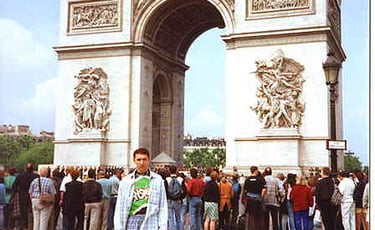

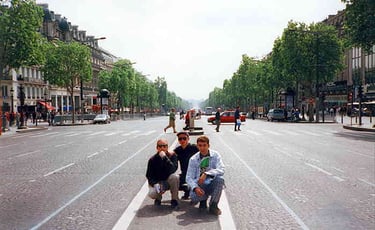

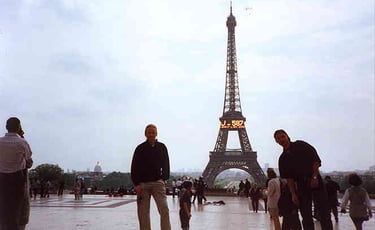

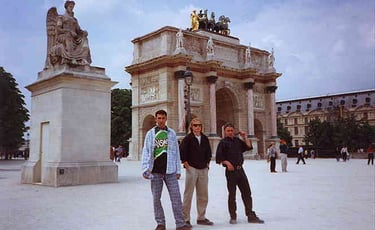

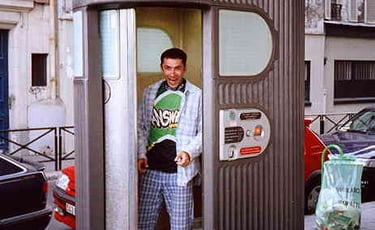

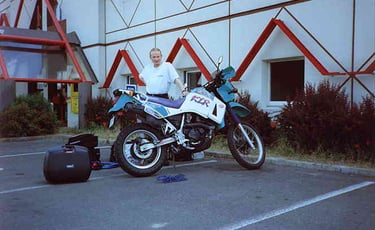

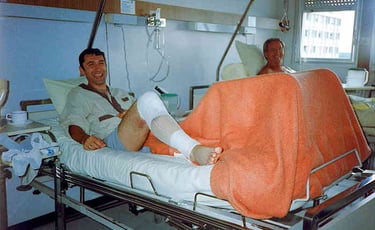

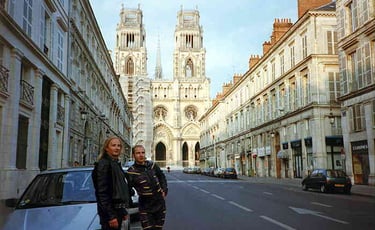

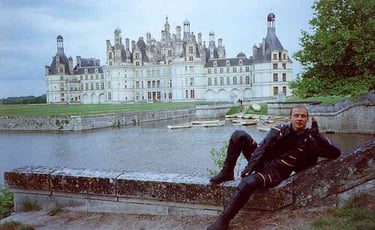



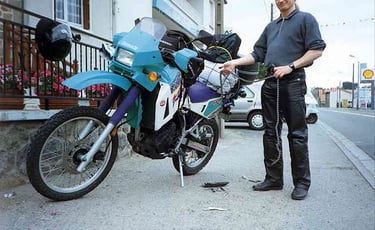

Sun, May 31, 98.FRANCE/SPAIN: from Bayonne to Salamanca.
J.: We crossed the border
and stopped for a short rest in San Sebastian.
G: Quick look around: it is a pretty city. I hope to return there once for longer. We withdrew some Spanish cash and left the town.
J.: Continued driving. It started raining. We were going several hours in the rain struggling with strong side wind at the same time. Fortunately we were well prepared. Having our rain suits paid off. We reached Salamanca at night. Spent the night Sun/Mon 31/1 in Hostel La Perla Salamantina.
Mon, June 1, 98. SPAIN: Salamanca. SPAIN/PORTUGAL drive
J.: In daylight, Salamanca appeared to be a beautiful baroque city full of even more beautiful Spanish girls. Well, we were late already and couldn’t afford to stay longer in the city.
Some interesting places in Salamanca:
· Cathedral Nueva [(1510-1733). From inside the cathedral, enter Cathedral Vieja (Old Cathedrral ) building begun in 11th century and it was consecrated in 1160.]
· [Patio de las Escuelas. ]
· Plaza Mayor. [Designed in 1733. Built in golden sandstone.]
· The ayuntamiento (town hall) [completed in 1755.]
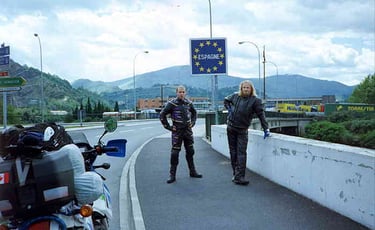


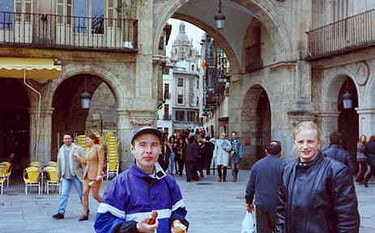
We crossed the Portuguese border
and headed for the mountains instead of going towards the ocean. Most of the ride was in the rain, again.
G: It was not difficult, but it was one of the most tiring rides: poor visibility, heavy rain, very bad roads and slippery conditions. We had to be extremely concentrated in order to keep the pace at a reasonable rate.
J.: We got lost a bit and drove extra 150 km. Driving through small towns was interesting. Major highways went right through small towns slaloming between the houses. Sometimes trucks passed as close as 20 centimeters or less in front of the main door of a house. Fortunately, people living in these houses had backdoors.
Portugal has nice hills and mountains. I was very intrigued by the orchards of a specific look. Later on I found out that they were olive orchards.
G: Once we left the mountains it stopped raining, yet the clouds were still hanging over us. Ahead we could see the sun, the line between clear sky and the clouds was so dramatic it created a sensation of going from the land of total darkness to the land of light and joy. Since it was already almost sunset the orange-red sun shined deep onto the cloud-covered land making it look like a fairytale picture.
J.: Lisbon is like a huge construction site. A city map from two years ago that we had was not valid anymore because of the construction development.
We reached the campsite at 2 a.m. (in Costa da Caparica – ½ hour from the city centre). (Night Mon/Tue/Wed 1/2/3)
Tue, June 2, 98. PORTUGAL: Lisbon.
J.: Before we headed for Lisbon, we met two Swiss guys on Yamaha Tenere and Suzuki DRBig whose tent was just beside ours.
We exchanged stories and experiences. Theirs was an interesting one. Two years ago they put their bikes on a plane and flew to Africa. For two months they were riding around Tanzania and Kenya. Well, people travel.
We took Greg’s bike and went to see Lisbon. Spent all day touring. We didn’t visit Expo ’98 because of lack of time. My most favourite part of the city was Alfama, a district of narrow and puzzling streets connected with narrow and steep stairs.
Despite the size of the streets, the streetcars were still in use there as a mode of transportation. The area was poor and dirty. Time goes really slow there.
G: You could see people just sitting or having a conversation, playing chess, having a drink or reading a paper. A very relaxed and peaceful community.
J.: Alfama was an introduction to the medinas (Old City in Arabic) in Fes, Marrakech, Tunis, Tripoli, Cairo and other Muslim cities in the region.
Baixa was another district we visited. It was much cleaner and sophisticated with its orderly designed streets and busy life - a sort of business district.
Wed, June 3, 98. PORTUGAL: Evora and Lagos.
J.: We left Lisbon, took a toll highway and visited Evora for few hours. A nice, small and clean city. The most famous place there was Capela dos Ossos (Chapel of Bones) in Igreja de Sao Francisco. The chapel is constructed with the bones and skulls of several thousand people, probably commemorating one of the great plagues that took place in medieval Europe.
There was also an Aqueduct from the Roman era with the houses built in between the spans. Neat.
We reached Lagos in the evening and spent the night Wed/Thu 3/4 on a campsite
Thu, June 4, 98. PORTUGAL/SPAIN: Lagos and drive to Seville.
G: In Lagos we came across many foreign travelers.
British “hooligans”- they traveled in their old beaten up camper van. They returned to the campsite late at night shouting and screaming for some reason. Like that wasn’t enough, they started throwing things around, among them bicycles! (I guess they were rentals). One landed not far from our tent but they did not come to pick it up or throw it again.
J.: Among others, there was a couple from Germany on their BMW 1100. Not only was the bike huge but also the amount of equipment they had. The couple was sort of “well in doubt” too. Still the bike didn’t seem to have any problems when they left in the morning. Our plan was to spent the weekend in Lagos and enjoy the weather. Unfortunately, the weather didn’t cooperate so the next day we set off to Seville.
We were approaching Seville when suddenly the temperature raised to 30C. We found a place to stay in the old part of the city - Pension San Esteban. (Night Thu/Fri 4/5). That evening we enjoyed the nightlife and a pleasant university atmosphere of the city.
G: On one of the plazas there was lots of young people talking and drinking. The situation intrigued us slightly so we asked what was the occasion of this large gathering. The answer was ”Oh, nothing, just sitting, talking and drinking.” - I saw that!!
Fri, June 5, 98. SPAIN: Seville and drive to Ceuta (Spanish Morocco).
J.: Spent the day visiting Interesting places:
· The biggest cathedral in the world. [Built on the site of Moorish Seville’s main mosque (1401-1506). The cathedral holds Christopher Columbus’ tomb. The adjoining tower, La Giralda was the mosque’s minaret and dates from the 12th century.]
· Alcazar, a residence of Muslim and Christian royalty [founded 10th century as a Moorish fortress. You’ll find similar architecture in Arab countries.]
Spain—a great place to visit. Clean, beautiful and not expensive.
The drive to Algeciras was fun because of the wide roads with lots of turns.
G: We stopped at one of the lots. We could already see Africa. I thought, what would it bring. The hills were full of modern windmills (not like in Holland) all in motion. What a noise!
The easiest thing to do in Algeciras was probably to buy ferry tickets. The agents were everywhere and the prices were almost the same so it made no sense to shop around.
The ferry to Ceuta (city that belongs to Spain)
was rough and windy but since we stayed inside the speedy catamaran, it did not affect us.
The first contact with the black continent was exciting but uneventful. That part of Africa looks exactly like Mediterranean Europe.
J.: We found a place to stay, nice and “clean” Pension Revellin (Night Fri/Sat 5/6). We got a bit scared because it was our first night in Africa but for no reason.
G: The owner seemed to be happy to have us despite the warning of the Lonely Planet book. He served us some wine and cheese. He even gave us a drink of a very delicious schnapps.
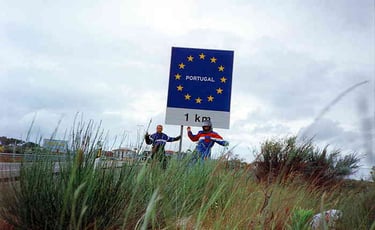



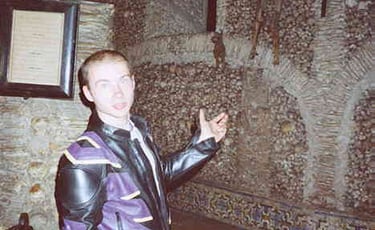


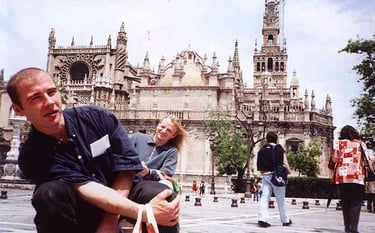
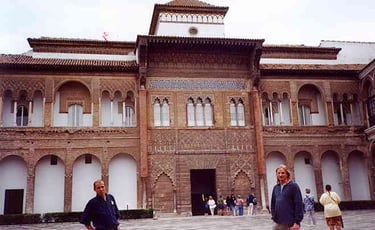

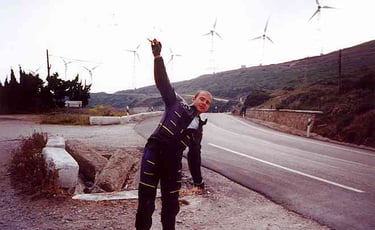

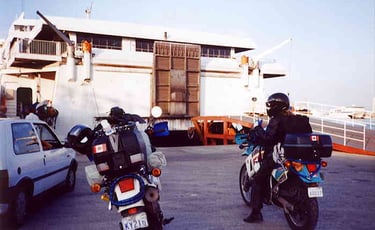

MOROCCO
Ceuta to Volubilis
Sat, June 6, 98. MOROCCO: Ceuta to Volubilis.
J.: Africa. This was a completely different world. We panicked. The border crossing was easy. By that time we fixed our CB Radios and we were using them openly even at the border. One of the officials (so he claimed), an extremely “long” gentleman who wore an even longer, white gown, sort of “pajama”, noticed our fancy communication devices and didn’t let us take them into Morocco. We had to deposit both radios on the border. Apart from that, no fees, no hidden charges, no problems! We took the road to Fes through Chefchaouen. Beautiful landscape: mountains, mountains, mountains…
In Morocco everybody is “your friend”. It was enough to stop in the middle of the city to have few guys around right away that offered their services. Lots of hassle.
Few times right in the middle of the road we were offered drugs. Some wanted us to stay at their “campsite.” Moroccans have a lot of imagination: a piece of field turns into a camping ground if only there are some tourists willing to pitch a tent there.
We slept at a regular campsite though (as per Moroccan standards) few kilometers from the ancient site of Volubilis (night Sat/Sun 6/7). There we met a German biker travelling on ’90 Honda Africa Twin with mileage of 140,000 km.
G: At the entrance a very pleasant, elderly “monsieur” approached us. He invited us in French with great courtesy and after showing us our place he asked: “voulez-vous manger quelque choose?” And went on offering us all kinds of fancy dishes.
It was amazing that in this Arab country almost everybody spoke French, even a farmer. Later we were to find out that Moroccans had a great talent for languages and that they spoke more than just Arabic and French. As Canadians, we were welcomed very warmly in Morocco (as well as in other Arabic countries as we would later find out). The following conversation usually followed: “You American?” (dry tone of voice), “No, we are from Canada.” “O! (warm smile), from Canada! Canada Dry! Canada Dry! Welcome!”
Sun, June 7, 98. MOROCCO: Volubilis, Moulay Idriss and drive to Fes.
J.: We visited the archeological site. Some facts about it: Best preserved Roman ruins in Morocco. Dates from 2nd and 3rd centuries AD. The site was originally settled by Carthaginians in 3rd century BC. Most attractive feature of Volubilis is the mosaics.
4.5 km from Volubilis there was the town of Moulay Idriss. The town was named after Morocco’s most revered saint, a great-grandson of the Prophet. Moulay Idriss arrived in Volubilis from Baghdad, converted the locals to Islam and established Morocco’s first imperial dynasty. The town is nestled in mountains. Non-Muslims are not allowed to stay overnight. Two bikers brought lots of curiosity in local children.
FES
The drive to Fes was short (100 km). We decided to take an off road short cut, a 30km mountain track. It was steep and rough, all the time on 1st gear going up and down on a very uneven stony surface. We were glad to finally make it to the main road. On the way we could see the real country life there: poor houses, dirty children, hard working peasants. As soon as we arrived in Fes, a hustler appeared on a moped. Driving beside us he started yelling something about a hotel. We stopped. He was trying to persuade us to follow him to a hotel of his choice. Having read the Lonely Planet guidebook (Lord, praise the Lonely Planet!), I insisted on going to a hotel that was recommended by the book. It was Hotel Central. To our surprise the price quoted by the woman at the reception (translated by the hustler) was twice as high as the price quoted by the book. After some explanation it appeared that the expensive room (US $10) had a washroom and the cheap one (US $5), didn’t. We opted for the cheap room (Night Sun/Mon 7/8). A well dressed (white suit, white shirt) man loitering by the hotel helped us find a place for our bikes. The parking attendant was happy to see our new “friend”. Interestingly, we paid him, not the attendant for the parking. All these guys were somehow related.
In the afternoon we took a bus to the medina. Our “well dressed friend” accompanied us. He insisted that he would show us all the secret places and that without his help we would get lost right away. It took really strong words to get rid of him. Well, we got lost right away. A maze of narrow streets was so complicated that even the guidebook didn’t contain all the streets. But that’s what makes a visit to the medina so exciting—to find the way out.
In the evening we had a really good and fulfilling meal in a local restaurant: couscous (a bowl of steamed semolina topped with a meat and vegetable sauce), tajine (meat and vegetable stew) and of course Moroccan tea. I loved it. Greg didn't.
Mon, June 8, 98. MOROCCO: Fes and drive to Meski.
J.: In the morning, we took more time to see interesting places in Fes:
· Bab Bou Jeloud.
· Medersa Bou Inania. [Built between 1350 and 1357.] For few dirhams we climbed the roof and saw the city and the Atlas Mountains.
· Tanneries.
G: Before we left, we said goodbye to our “well dressed friend” who to our surprise was still “well dressed.” Well, it is just that his dress was not so clean any more. I guess he did not change. He insisted on giving him a pack of cigarettes for his “friendship,” so I, the kindhearted person, gave him one of my DuMorriere gift packs.
MESKI AND MERZOUGA
J.: The drive to Meski was nice, especially driving through the Gorge du Ziz. It got hot: near 40 C. Driving in leathers was OK, until we had to stop on the red light or to ask for directions. There were three colours in Morocco desert areas: blue sky, red/brown landscape including houses, and occasional green tress, oases or valleys. We truly enjoyed the ride. For me most impressive was the vastness of the desert and half-desert.
The last part of the drive was tricky. We drove at night. There was lots of bicycle and donkey riders with no lights on the main road, which was not lit either.
First impression of Meski was astonishing: tall palm trees, sand and dry hot air, a perfect small oasis.
Right on our arrival we were surrounded by “friends” who wanted to sell us “stuff”. There were “friends” even in the toilet. Every time you went there they would accompany you inside! For what?
The night (Mon/Tue 8/9) was pleasant, warm and very dry. The next day we found out that the site was situated on the Ziz River. There was a natural swimming pool at the campsite with the water coming out of the rock into the pool.
Ziz River with its line of palm trees was right beside. All around there was a desert plateau.
Tue, June 9, 98. MOROCCO: Meski, Gorge du Ziz, Red Dunes.
J.: The next morning we began the day bargaining with the local merchants. Greg accepted an invitation for breakfast from a merchant. It was so obvious that later on it would be very difficult not to buy anything. We got caught in a Moroccan trap: cup of tea. Eventually we both bought handmade knives. We paid for them with money plus an old T-shirt, pair of socks and a lock. It took about 2 hours to finalize the deal. It was an interesting experience.
It was hot and dry all day. Around noon we took a ride to the desert. We came back around 9 p.m. The plan was to reach Merzouga, but we didn’t get there.
G: However, we got to the red dunes of Erg Chebbi.
It was incredible. A sea or rather hills of pure sand and it was all red. Awesome. We goofed around for awhile,
took a couple of pictures, talked to a very nice Tuareg man in a blue shash who just happen to be there (!?)
and decided to head back in order to be back at the camp before dark. We were driving after dark anyway.
J.: Dune riding was fun. You’d have to control your movements all the time, and work with gears precisely. The surface was very uneven. The bikes passed the test very well. It was the best day of the trip so far.
We spent the night Tue/Wed 9/10 on the same camp in Meski. Greg cooked a soup. Our “friends” kept bothering us.
TODRA GORGE
Wed, June 10, 98. MOROCCO: Gorge du Ziz, Todra Gorge, Road to Ouarzazate
J.: We said farewell to our “friends” in the morning and drove to Todra Gorge. Life in this area is focused around the river.
Above the gorge there is nothing but sand and rock: the desert. There is plenty of life in the heart of the valley however.
Todra Gorge was amazing.
The narrowest place of the Todra Gorge was 300 metres high and 10 meters wide.
The road was rough: a track across a stream.
First few passes were easy. The last one was deceptive. I checked the creek before attempting. Unfortunately, I didn’t really go where I was supposed to and as a result I fell.
We decided to turn around, but I had to go through the same creek again and I fell again. No damage, of course—an off-road bike. For the fall, I blamed the tires but really it was just lack of experience. Greg was doing fine. He didn’t even fall once. We met two German bikers.
We bought a shush (blue turban). The shush is used for protection against sun and sand in the desert. There was an old man on a jackass. He was posing there for pictures and collecting money (maybe his only source of income).
We reached Ouarzazate in the evening and stayed there for the night Wed/Thu 10/11 at a campsite (US$ 1.50 a person).
MERRAKECH
Thu, June 11, 98. MOROCCO: Road to Tichka Pass, Marrakech.
J.: The next morning we set off to Marrakech. We stopped for a short break on the shoulder. After a few minutes, three young girls showed up. They were carrying crops. We were trying to communicate with them, but they were really scared. Who knows, maybe we were the first foreigners they’d talked to.
We reached the Tichka Pass. Again, we were “attacked” by merchants. Eventually I bought a stone (pyrite) for 10 dirhams. The starting price was 300! I bargained! Greg got a stone in exchange for a contraceptive he just happened to have. Good deal!
The road from the Tichka Pass to Marrakech was very picturesque.
G: It was the high Atlas and there was no end to numerous turns and twists.
Being in the mountains was a great relief from the constant heat of the desert. I think the temperature dropped to 25C. We reached Marrakech around noon, walked around the city and had some food in a local joint.
J.: We tried to make some money by displaying our bikes ;-) among jugglers, storytellers, snake charmers,
magicians, acrobats and other lunatics at famous Place Djemaa el-Fna but we were not offered any dirhams. However, some tourists found our presence interesting and started taking pictures. We did some shopping. Another example of good bargaining: the price for a T-shirt was 120, we bought 2 for 75.
Almost everyday the only food we ate was water or Fanta and bread. This is what the temperature does to you. It is possible to catch a cold in high temperatures. This is what happened to Greg. I guess he got dehydrated.
We spent the night Thu/Fri 11/12 at a campsite near Rabat.
Fri, June 12, 98. MOROCCO: Road to Ceuta, Ferry to Algeziras, Drive to Torremolinos
G.: We took the only Moroccan paid highway, which ran along the ocean. The face wind was so incredibly strong that we felt like we were little toy riders tossed left and right at every blow of a “monster”.
J.: In Morocco (and all other Arab countries except Libya and Syria) we were withdrawing cash from ATM machines. We were also surprised by a number of gas stations accepting credit cards.
We calculated our expenses and spent all leftover cash. At the tollbooth, the officer demanded more than we had. So we offered him French, Spanish, US funds. He didn’t want to accept either and told us to go back when we entered the highway (200 km!). Finally, we talked to the cops and they persuaded the toll attendant to let us through. Later on we came across a dead horse hit probably by a truck and left to rot.
On the border in Ceuta we got our CB Radios back, took ferry to Algeciras (which leaves Ceuta every ½ hour), and kept driving until we reached Torremolinos (near Malaga), around midnight.
G: It was a relief to be back on the “old continent” considering that I had a high temperature and felt really miserable. It was pleasantly warm, not hot anymore. That is what I needed.
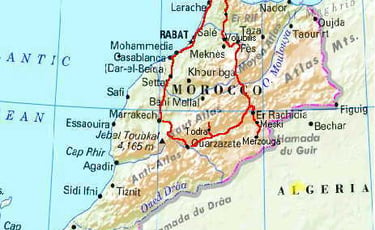

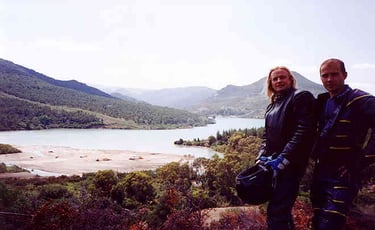

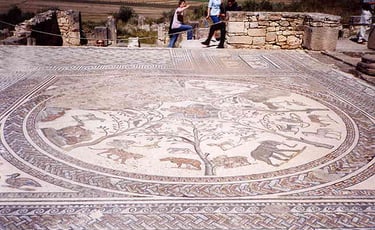

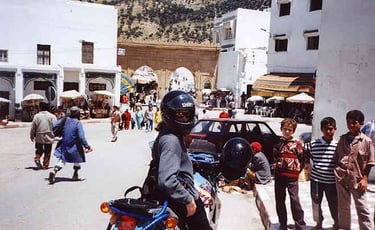


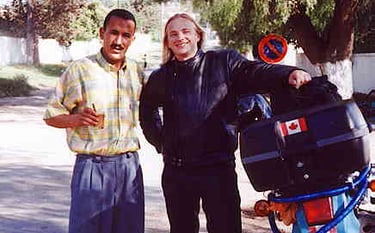
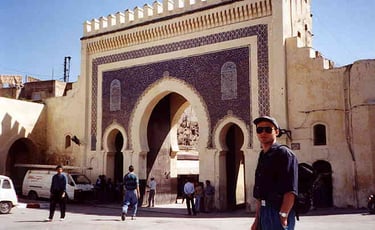


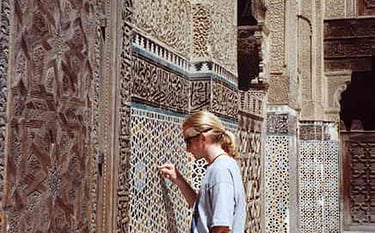
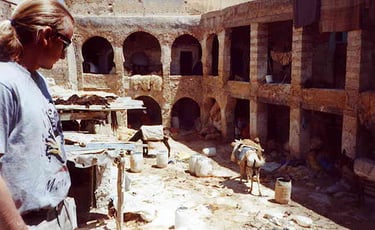

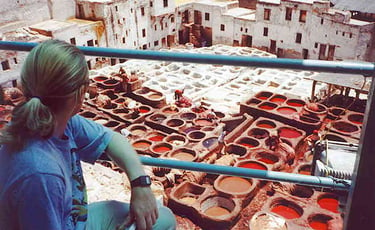

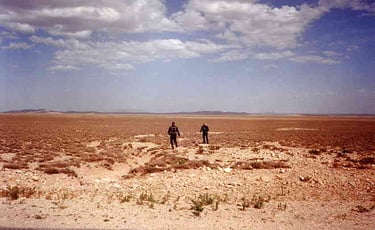

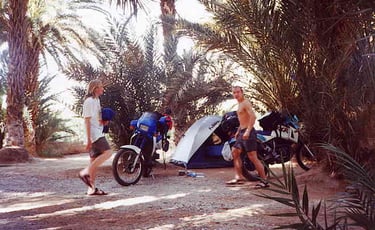



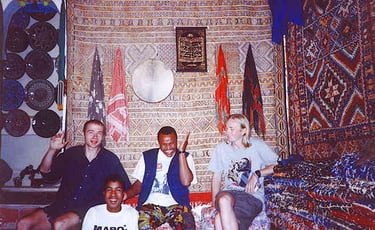

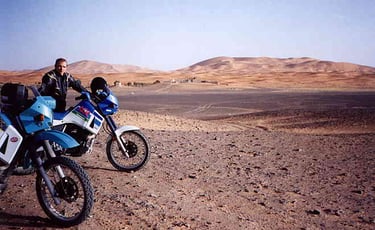

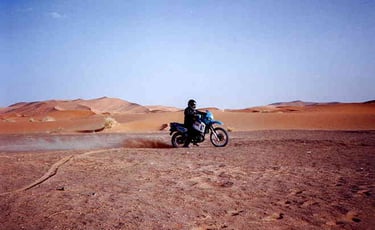

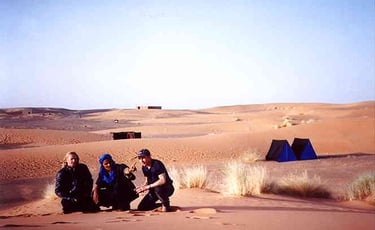



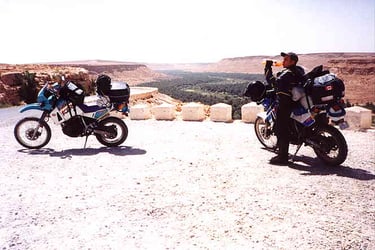
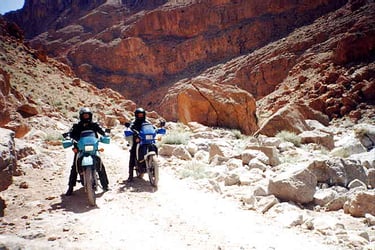
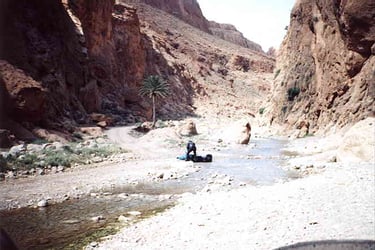
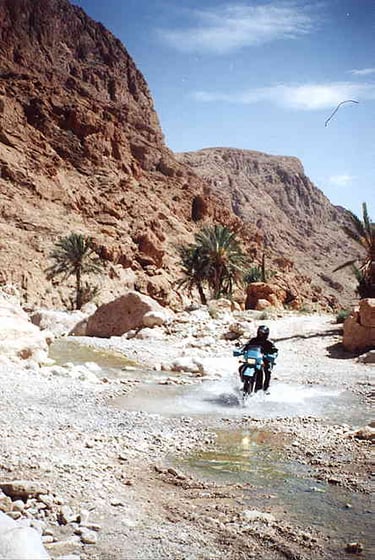






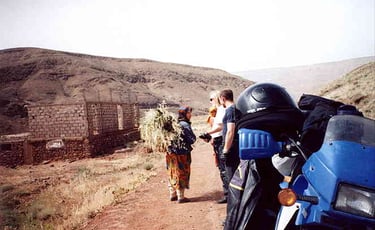

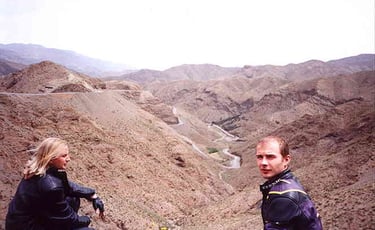

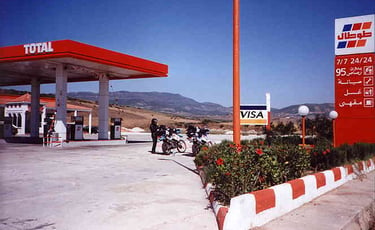



EUROPE
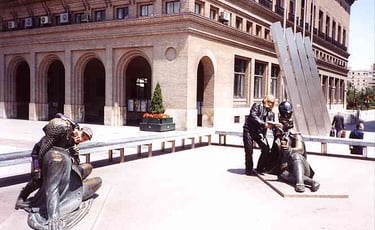

SPAIN
Fri/Sat/Sun, June 12/13/14, 98. SPAIN: Torremolinos
J.: While Greg was recovering from his desert cold, I was enjoying Costa del Sol beach and its guests. I met tourists from Canada, Germany, US, Spain and the Netherlands.
G: Oh, yeah. We met some Canadian girls from Quebec and an American guy who traveled together and a very talkative Italian fellow from Cefalu on Sicily who dearly insisted to visit him. Oh, well, we would see about that.
Mon, June 15, 98. SPAIN: Torremolinos to near Zaragoza
J.: The ride was OK. Beautiful views, great free highway. We passed Madrid and headed further north. It was much easier (and cheaper) simply to take any minor road off the highway and find a piece of ground suitable for pitching a tent than to look for a hotel or a campground. That is what we did for the night of Mon/Tue 15/16. We slept in the forest.
Tue, June 16, 98. SPAIN/ANDORRA/FRANCE.
J.: We stopped in Zaragoza for couple of hours. Visited a 500m long main square, Plaza de Nuestra Senora del Pilar and Basilica de Nuestra Senora del Pilar (17th century). Francisco Goya, the Spanish writer was sitting proudly on the obelisk. I guess he was from around.
That’s it. Time to saddle the horses again.
ANDORRA
Andorra: great place for shopping (duty-free zone—both French and Spanish currency is used) and skiing: modern buildings and the mountains; one way streets; strict parking officers. And nothing else!
Before us there was another mountain range we chose to cross, Pyrenees. We reached Port d’Envalira (2708m), the highest pass in the Pyrenees, in thick fog and almost freezing temperature. Visibility: 10 meters. It was cold and very slippery! It was the last time I was cold until we reached Poland at the beginning of August! Yeah!
FRANCE
Late at night, we reached Castelnaudary, France. Ania, my old university friend from Poland, and her Frenchman husband, Philippe, were kind to provide us with accommodation and long night talk (Night Tue/Wed 16/17).
ITALY
Wed, June 17, 98. FRANCE/ITALY
J.: We left for Italy on Wednesday morning. That day, we beat our record: 910 km in a single day. It cost each of us US $40 on tolls and US $40 on gas. Picturesque highway: bridges or tunnels for hundreds of km. Constant speed of 130-140 km/h. We got off the highway in Livorno and had a pizza in an authentic Italian pizzeria. Food was expensive in Italy, especially after an unexpected cover charge was added. As soon as we finished the meal, crowds filled the streets. Crazy car, motorbike and moped drivers were chasing each other around the square to celebrate Italy victory in the World Cup ’98 game. Take it easy, guys—it wasn’t even a semifinal! (Night Wed/Thu 17/18 in Livorno at a campsite.)
Thu, June 18, 98. ITALY: Rome.
J.: We reached the Eternal City. Pitched a tent at the seashore in Ostia and rode to Rome.
Greg used to live in Rome for half a year so we took his bike. We toured the city at an extreme speed. Driving was crazy, but because of Greg’s past experience, it seemed like he was a native Italian. We visited:
* St Peter’s Square (Vatican City), [St Peter’s Basilica stands on the site where St Peter was buried. The first church on the site was built in the 4th century. The work on what’s now St Peter’s Basilica took place in 16th century],
* Colosseum,
* Piazza Navona,
* Fontana dei Fiumi [1732].
We came back to Ostia for the night Thu/Fri 18/19.
G: There are always many people on Rome’s every plaza. It may seem like everybody always moves somewhere but in reality they all take it easy, locals and tourists. I love Rome, it is not the cleanest city in the world but at least it has a heart.
Fri, June 19, 98. ITALY: Ferry to Sicily.
J.: The next morning we rode the whole day through Abruzzi and Calabria (more beautiful mountains) and finally took a ferry to Sicily. We spent the night Fri/Sat 19/20 on the camp in Milazzo.
Sat, June 20, 98. ITALY: Sicily.
J.: Spent on driving to Palermo. Half of the road from Milazzo to Trapani was an expressway, half a regular road. The last one was much slower but more fun too.
G: Halfway from Milazzo to Palermo there was the town of Cefalu where our Italian “amico” we met in Spain lived. Jacek pressed on, I guess we wouldn’t be visiting him.
J.: I think that wearing a safety helmet either is not required on Sicily or no one respects the law. We kept our “hats” on. We arrived in Trapani hoping to find a ferry to Tunis that night (according to Lonely Planet there should be one). Unfortunately, we found out from a local homeless man that the next ferry would be going on Monday. I guess he knew it all. After all he lived right on the pier. We went back to Palermo (100 km or so) and spent nights Sat/Sun/Mon 20/21/22 there.
Sun, June 21, 98. ITALY: Palermo.
J.: Last few days were tiring and busy riding. I decided to be sexy (lazy) and stopped shaving. Few more days and I would become an authentic Viking from Finland.
We spent Sunday relaxing. Went to see Palermo. Overall, quite a big disappointment from a tourist perspective. It’s not a clean city. Lots of cats and dogs. Dirty.
We saw: Cattedrale, Porta Nuova, the Quattro Canti (the intersection of Via Vittoria Emanuele and Via Maqueda, four corners of Palermo), Piazza Pretoria, with a fountain (Fontana Pretoria). It’s also called the Fountain of Shame because of its nude figures.
The nightlife was OK. Didn’t see any Mafiosi.

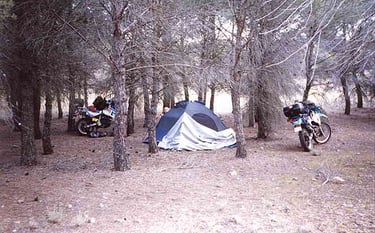


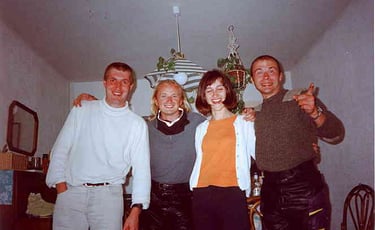

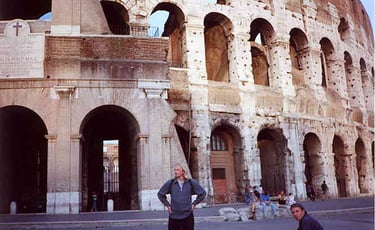


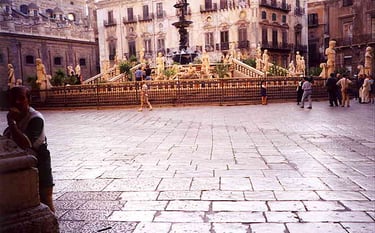
TUNISIA AND LYBIA
Mon, June 22, 98. ITALY: Palermo, Trapani / TUNISIA: Tunis.
J.: Drove to Trapani and took a ferry to Tunis.
Most of the “travelers” on the ferry were Tunisians living in Europe. It looked like they were serious importers/exporters.
Ferry to Tunis
G: Every car was fully stuffed with things, rugs etc. All cars also had loads of stuff on their roofs and on trailers. Are things actually cheaper in Italy?
J.: The ferry ride was 6 hours long. We were entertained first by interesting view of the islands around and then by the Pom-Pom girls (kind of cheerleaders) who were travelling to Tunisia for a dance festival. We also met a Swiss man and his Dutch wife who were planning to go through Tunisian and Algerian desert to Morocco. He must have been insane to go to Algeria with that beautiful blonde woman she was. Good luck! We also met 3 French travelers in a camper who were planning to reach South Africa in 8 months.
G.: It took them a year to prepare all necessary papers and equipment. It seemed like they were prepared for the worst. Real trappers. Their camper-truck was totally prepared to withstand any terrain. It had a very tall reinforced suspension, extra tires, ropes and pulleys, shovels, sand-rails, light guards and inside all the amenities. Good luck guys!
Tunisia.
J.: First impression was positive. The roads were dry but slippery. After a desperate search, we found a campsite in Hammam Lif (half hour outside the city). We were the only guests. Nights 22/23/24/25 Mon/Tue/Wed/Thu there.
Tue, June 23, 98. TUNISIA: Tunis.
J.: First item on the agenda was to get Libyan visas. The Libyan travel agent, Hussein Founi that Greg contacted early in the spring, was to send our invitations to the Libyan embassy in Tunis. All the invitations were filed with a number. Because we didn’t know the number, the embassy official refused to accept our passports to issue visas. We had to call Hussein to record the number. Only then we were able to submit our passports. We paid US$ 20 each.
The old and modern buildings had a similar taste.
Modern part of the medina
We saw: Bab Bhar (Porte de France), the Great Mosque (the Zitouna Mosque or the Mosque of the Olive Tree—9th century), etc.
We noticed quite an interesting fact about Tunisian women. They were smiling very warmly to all foreigners (or maybe to the handsome ones like us). Even a policewoman returned my smile! Both men and women were dressed like Europeans. Another surprise was the presence of the red light district. Suddenly we found ourselves on a street with men walking from one window to another and women waiting for customers. How is it possible? It is a Muslim country! Later on one of the Tunisians explained: “I am a Muslim when I want to.”
Another European thing was a huge Pinky Mall on Avenue de Carthage just across from the Carcassonne Restaurant where we ate (great food).
Wed, June 24, 98. TUNISIA: Tunis.
J.: The next day we went to check out our visa applications. Libya uses Arabic script only and all the documents including passports had to be translated into Arabic. Greg was travelling with his Canadian and Polish passports. I was using my Polish passport only. Because Canada is a multicultural country, the Arabic translation of the Canadian passport (a stamp in the passport) was quite easy to obtain. A case with my passport was more difficult. The Polish Consulate General in Toronto informed me that they would never translate my passport into Arabic because there was no procedure pertaining to this kind of situation. So I decided to do my own translation. Still in Canada, using my old typewriter, I translated all the necessary particulars with assistance of a friend who spoke Arabic. Now in Tunis, they told me that my translation was not good enough, because the stamp was missing. The official sent us to a translator on the other side of the city. The translator looked at the translation, complained about mistakes made, but finally stamped my passport at no charge! Back at the embassy, the officer looked at the stamp, and smiled warmly. This was what he needed. The visas were ready the next day.
That day we visited Carthage and Tunis again.
Carthage.
A disappointing archeological site. Founded around 814 BC by Phoenicians. In 146 BC Carthage fell and the city was destroyed by Roman conquerors. The only slightly interesting sites were: Antonine Baths or rather what’s left of them, Roman Villa and Byrsa Quarter.
Back in Tunis.
While walking around the city we were approached by a hustler. He was much less annoying than his Moroccan colleagues. He took us to the top of one of the shops. The view of the city was very nice, a sea of TV antennas and minarets. Down at the shop, we had a chance to see the ancient way of knitting traditional carpets.
Women are knitting the carpets, Tunis
In the middle of the street, we met our French friends with a camper-truck from a ferry. They just got off the ferry after over 2 days in the customs! They were missing some documents for the truck and the officials kept them this long! Oh, guys, you will really need a lot of luck to cross Africa…
In the evening we stopped at a store near our campsite to get some water and food. Two young Tunisians approached us and asked for a ride to a discotheque at a resort. They surely knew that with European tourists it would be much easier to get in. We said: Sure! Since we were in the mood for some fun, we went with them. The club was a major disappointment. We tried another resort, just next door. This place was much busier. Unfortunately, our new friends were wearing shorts and the staff didn’t let them in. They let us in, though. We missed a fashion show by few minutes but were lucky enough to witness a belly dance performance (very interesting). Right after that, we attended a disco. There was a catastrophic shortage of young Europeans (most of the tourists were people in their 50s and 60s), so the six beautiful Tunisian models from the show we just missed, were very happy to find two handsome guys. We were happy too and had a very good time. Yeah!
Thu, June 25, 98. TUNISIA: Tunis.
J.: We got the Libyan visas. Yeah!
We visited the Bardo Museum—a superb collection of items organized in sections, which covered the Carthaginian, Roman, Palaeo-Christian and Arab-Islamic eras. An impressive collection of mosaics from the Roman era made up the most interesting part of exposition.
Back at the camp: the manager was expecting a large group of Tunisian tourists and suggested that we leave. Well, we left in the afternoon for Nabeul (50 km or so outside Tunis) where we slept at a campsite by a hotel (night Thu/Fri 25/26). We met some German tourists who were coming back from a desert safari in Libya. They told us interesting stories about Libya.
Fri, June 26, 98. TUNISIA: Nabeul to Jerba.
J.: After four days of resting, our bikes were finally on the road again. The ride was very pleasant. We visited…
… Kairouan (as a religious centre, it is the most important place in the country founded in 7th century).
The Great Mosque in Kairouan built in 670 AD; the 35-metre minaret is the oldest standing minaret in the world (8th century).
Here we asked a carpet merchant to watch our bikes for us. After touring the city, which was very quite because it was Friday (Muslim holiday), the merchant was trying to sell us some carpets but we really had no room for anything.
Beautiful carpets
… and El Jem. In El Jem there is a colosseum (230-238 AD) not much smaller than its famous counterpart in Rome (138 by 114 metres; capacity: 30,000).
Colosseum in El Jem
A great thing about travelling on a motorbike in a Third World country was that the bikes were very noticeable and it was very easy to find people happy to watch them for few hours. For free or a very small tip.
Then we drove to Jerba. Last portion of the trip was at night. Same as in Morocco, drivers use headlights in a very strange fashion. They either keep their high beams on or turn the lights off completely.
Ferry to Jerba.
On the ferryboat we made some friends, again. Boys age 12-15 were making money selling gum. Some of them were very obnoxious, some very nice. Interesting, every boy beside Arabic spoke a different language. Tourist influence, I guess.
We spent the night Fri/Sat/Sun/Mon 26/27/28/29 at a campsite in Aghir.
Sat, June 27, 98. TUNISIA: Jerba, Matmata, Douz, Jerba.
J.: The next day we took a day trip to Matmata, Douz and back to Jerba.
A rough ride on a stony dirt road over very treacherous hills, led us to Matmata. We stopped for a break in a desert village. A group of boys appeared. They were very happy to have a chance to talk to strangers. So were we.
Friendly Tunisians
Matmata.
The Berbers of the Matmata area went underground centuries ago to escape the extreme heat of summer.
Matmata, Tunisia
The dwellings of very simple and neat construction, were dug deep in the ground what made them more bearable to live in. Outside temperature in the low 40s, inside – in the middle 20s. Matmata was selected as a location for the movie Star Wars.
After Matmata we kept riding through even more deserted areas. At one point there was road construction. Its only indication was a single blue sign: an arrow pointing to the right. For about 3 kms we had to ride in the soft sand. The motorcycles were dancing right and left. It was easy to get lost. Detour was so badly marked that I kept driving in the sand while Greg got off the track back to the hard surface road simply because he noticed the construction zone ended.
Douz
Douz was great. Huge sea of sand, this time white-yellow (red dunes in Morocco).
White sand in Douz, Tunisia
We came across “package” tourists, who were Polish too. Numerous buses flock to Douz for a desert experience. The tourists are chased out of the buses, then dressed with some “authentic” Berber gowns, put on camels,
Package tourists
driven for an hour and chased back to the air-conditioned vehicles. If you go in a “package”, that will be the only desert ride you experience. We spent few hours just sitting and enjoying the heat, dryness and the view.
In the evening back on Jerba, we visited a disco in the Royal Gardens Hotel.
Typical beach resort - this is NOT Tunisia
The lineup was long (mostly consisted of Arabs) but as soon as the security noticed us, we were rushed inside like VIPs. We were subjected to racism. Inside there was lots of European tourist as well as Tunisian men looking (some quite successfully) for amorous adventures with older European women.
Sun, June 28, 98. TUNISIA: Jerba.
J.: It was our day off. We spent the whole day on “Beach entertainment”.
Libya
Mon, June 29, 98. LIBYA: border to Tripoli.
J.: In a city near the Tunisian-Libyan border, we bought some Libyan money. There were literally hundreds of moneychangers around. Of course, we bargained.
The Tunisian border procedure was quick and simple. On the other side, were Muawe (our travel agent’s partner) and his driver were waiting for us. Muawe paid for our plates, insurance, Carnet de Passage, and customs. Everything lasted for over 3 hours. Later on we reimbursed him with US$175 each. The black-market value of the dollar was 10 times higher than the official rate. We would have probably arranged the border crossing by ourselves but it would cost the same plus huge headache and extra time. For example, we would have paid US$200 each for the plates instead of US$20 each. On the border we could see the meticulous work of the customs. All the cars leaving Libya were checked. Custom officers were confiscating all types of food: eggs, onions, pasta. There is a shortage of food in the Jamahiriya. We on the other hand weren’t even asked to open our bags, but the officer asked us politely if we had any alcohol or pornographic magazines (!). The answer for both questions was No.
Finally we enter The Socialist People’s Libyan Arab Jamahiriya (State of the Masses). Yeah!
The highway (the only west-east highway) was good, straight and well surfaced. One of the characteristics of Libya was that it was dirty. On both sides of the road, regardless whether it was 5 or 105 km from a bigger city, there was garbage all around: old tires, rubble, junk.
We were following Muawi’s car (20 or more years old Japanese make). He was driving very slowly (90 km/h). If not for him we wouldn’t know where to go: all road signs were in Arabic only. Libya suffers from air embargo imposed by UN. As a result, the automobile parts are impossible to obtain. That’s why, you can see all kinds of half-dead or completely dead cars on the road.
Sabratha.
We stopped at a restaurant and had a pizza (!). Before we reached Tripoli, we visited the archeological site of Sabratha. Our hosts were so nice to take us inside and they actually enjoyed the site with us. The city was first settled by the Phoenicians, but as seen today, dates from the 1st and 2nd centuries AD.
Sabratha, Libya Theatre: built in the late 2nd century AD. 108 Corinthian columns.
We arrived in Tripoli and with the help of our friends were placed in a youth hostel. It was filthy but the staff and guests were very friendly. They probably never had any European tourists in the hostel especially since one night’s stay cost 3 dinars (US$ 1).
G: The only guests were some workers and some migrants from different African countries. A very pleasant man approached me. He spoke good English, he was black and he was from Nigeria. He explained to me his situation: it was very sad, and virtually begged me to “loan” him 100$US. His story was so touching that I was almost convinced. I was also a bit afraid, he was very big too. Finally I gently concluded our conversation. We ended up exchanging addresses. Thanks God, he wasn’t hurt.
Night Mon/Tue/Wed 29/30/1 there.
Tue, June 30, 98. LIBYA: Tripoli (Tarabulus in Arabic).
J.: In the morning Muawe gave us a tour of Tripoli. We visited The Jamahiriya Museum—a very interesting set of exhibits laid out chronologically starting with prehistory and early Libyan tribal history up until the times of Gaddafi’s revolution. Then we had a walk around the city centre. The streets were very dirty.
Typical Lybian street
Impressive communist-like sculptures “beautified” the city. Even postcards were ugly. There were no women on the streets. It’s truly Islamic country. All the signs were in Arabic so we had to guess most of them. I called my parents in Poland. In order to make international call, I went to the post office. I had to submit my passport and fill out a form. The charge was around US$ 2 per minute. Tired of walking around we decided to have a drink. We ordered beer! Beer in Libya! Sure! After all, “it’s a rich country”. It was a non-alcoholic Bavaria.
G: When sitting at a table we were approached by two young guys. They could speak only few words in English so we used mostly sign language. At one moment one of them said: “you are beautiful”. I was totally confused. I tried to explain to him that a man does not say that to another man but it was too difficult. I knew and I saw earlier that Arab men sometimes hold hands when they walk and it is a widely accepted sign of male bonding, but these two boys were definitely going a different way. But who really knows.
Finally we met our agent, Hussain. He took us to a very nice pizzeria where we talked and got to know each other better. It was quite a surprise when a beautiful woman walked in the pizzeria. I was very curious so I asked Hussain. He stroke a conversation with her. She spoke very good English and was a former flight attendant. Hussain later explained that after dark some women have the courage to walk out on the streets dressed in modern cloths. She could have been the perfect example of that trend. But, who really knew who she was.
Wed, July 1, 98. LIBYA: Tripoli, Leptis Magna, road to Sirt.
J.: Hussein insisted that we stay another day, but we decided to go on. He provided us with “translation” of major road signs in Arabic. Holly cow! This language was so different from the Latin script! Somehow we managed to figure out all these scribbles.
Leptis Magna
The next place to visit was Leptis Magna, the MOST IMPRESSIVE of all the archeological sites we visited. Because of the minimal number of tourists in Libya, we were the second group that day to visit the place. At the end of our visit (over 3 hours), we met 6 Libyan tourist, the only people walking around this stunning place.
Theatre in Leptis Magna: with Lybian tourist Severan Forum. 60 x 100 meters. Leptis Magna, Libya
Because each visitor had to sign the guest book, just out of curiousity we checked previous days. On average, there were 5-6 tourist a day in Leptis Magna. I predict that as soon as Libya opens up (if ever), Leptis Magna will become at least as busy as Ephesus in Turkey. The former overshadows the latter by far.
Facts: Roman city from 1st and 2nd century AD.
Severan Basilica Leptis Magna: MAGNIFICENT!!!
The driving in Libya was interesting and boring at the same time. Boring because the road was straight and the distances between settlements were huge (50-100-200 km). Interesting, because the desert landscape was always different. The cost of gas: US$0.05 per liter. “It’s a rich country.”
It got dark and we were looking for a place to sleep. We rode around 500m off the road and found a quiet beach. Night Wed/Thu 1/2 there. We didn’t pitch the tent; it was so warm. The sky was full of stars. The air was definitely clean. To the north it was at least 500 km to the nearest land, to the south it was Sahara desert for at least 2000 km, to the west there was a small settlement 100 km away and to the east there was the city of Sirt 100 km away. What a view! Millions of stars!!! Goodnight. Let’s hope nothing will bite.
Thu, July 2, 98. LIBYA: ride from the beach near Sirt to the beach near Bengazi.
J.: In the morning we found lots of “balls” (kind of sea plant tossed away by the water). We “played soccer.” Without usual garbage, it wouldn’t be an authentic Libyan wild beach. Well, all around there was plenty of trash. It’s Libya. I took a morning swim in the sea sharing environment with lots or of the jellyfish, and skillfully managed to avoid being stung.
Great place to spend a night, Libya
We set off. The next stop was to be Benghazi.
Salt lake.
We stopped at the salt lake that stretched several km along the sea to take few pictures.
Salt lake
The ride
After few hours of riding, we came across a tiny village. There was even a small restaurant or rather eatery. We ordered kofta and agreed on the price. Suddenly, an elegant black Mercedes appeared in front of the restaurant. A seriously looking man in a black suit got out of the car. He talked for a minute to the waiter (owner?) of the restaurant and left. The waiter said that it was a government official and that he paid for our meal!!! “It’s a rich country!”
G: The waiter was an Algerian working in Libya. He asked if it was possible to sponsor him. What is it with everybody wanting to leave Libya? It is a rich country! We exchanged addresses.
J.: The highway was in good condition. Every now and then there was a stinking spot with remains of a camel. At night, these animals look for warm spots (asphalt keeps the temperature longer than sand) and many of them get killed by highway vehicles.
Beach near Benghazi.
Again, we were looking for a place to sleep. It was easier to find a beach than a hotel. Signs in Arabic! To get to the beach we had to cross a garbage field. I don’t think it was a planned dump—just a convenient place for trash.
We found the beach. We shared it with several Libyans for whom it was a night out—the next day was Friday, a holiday for Muslims. That night the humidity was unbearable. In the morning the brake disks were covered with rust as if we didn’t touch the bikes for at least a month. Night Thu/Fri 2/3 there.
Beach near Benghazi, Libya
Fri, July 3, 98. LIBYA: from Benghazi to Susah through Green Mountains
Green Mountains.
Kept driving.
G: The best breakfast one may have in a hot country is a watermelon. We stopped at the fruit stand beside the road (not for the first time and not last) and chose the juiciest melon. It was divine, very wet and filling.
Watermelon! The best!
J.: In the middle of the Green Mountains, Greg’s bike odometer hit 50,000 km. We reached Sousa in the late afternoon, found accommodation in a resort for Libyan tourists and went to see Appolonia and Cyrene, two ancient sites. The resort was nice; the beach—clean; the room—basic. Cockroaches outnumbered people by at least 50 times and their size was “African”. I killed around 20. (Night Fri/Sat 3/4 there).
Appolonia.
The site was empty, except for the sheep but strangely there was an attendant who opened the door for us. Today the ruins represent only half of the former city. The rest is already under water. Looking on the sea one can spot remains some 200 meters out in the sea sticking out of the water. Slowly we were getting tired of ancient excavations.
Ancient Appolonia, Libya
Cyrene.
There were few tourists, including some from Sri Lanka! The city was founded by Greek immigrants around 631 BC. In the Forum of Proculus we met some local children. Greg played soccer with them—in the museum (!) among 2½ thousand years old structures!
